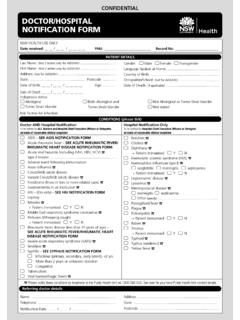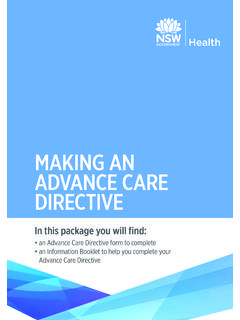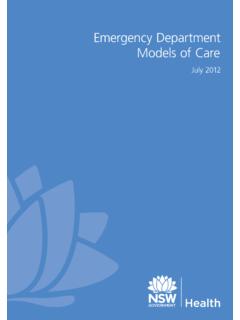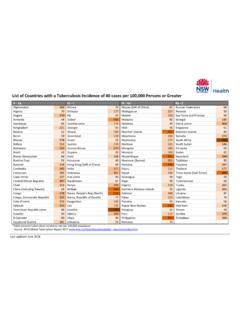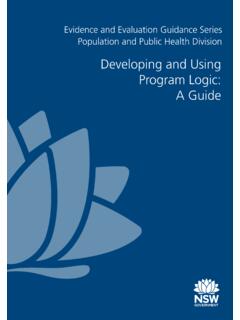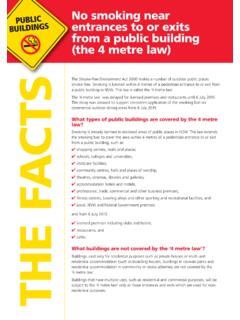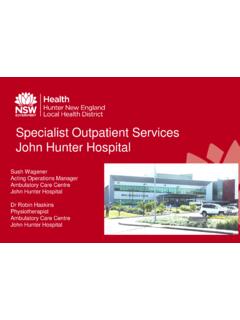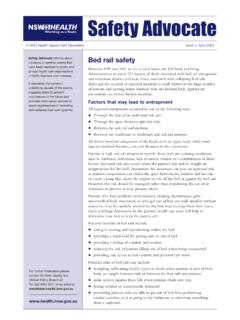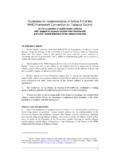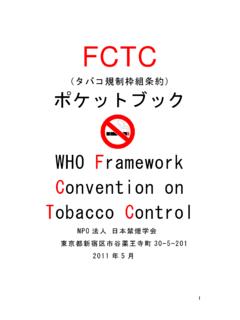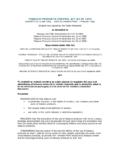Transcription of NSW Tobacco Strategy - NSW Health
1 NSW Tobacco Strategy2012 2017 NSW MINISTRY OF Health 73 Miller Street NORTH SYDNEY NSW 2060 Tel. (02) 9391 9000 Fax. (02) 9391 9101 TTY. (02) 9391 9900 work is copyright. It may be reproduced in whole or in part for study or training purposes subject to the inclusion of an acknowledgement of the source. It may not be reproduced for commercial usage or sale. Reproduction for purposes other than those indicated above requires written permission from the NSW Ministry of Health . NSW Ministry of Health 2012 SHPN (CHA) 100550 ISBN 978 1 74187 571 3 Further copies of this document can be downloaded from the NSW Health website 2012 NSW Tobacco Strategy 2012-2017 NSW Health PaGe 1 ContentsForeword ..2 Executive Summary ..3 Part OneBackground and Context for Tobacco control in NSW ..4 Introduction ..4 Policy Context ..4Pa r t TwoThe Approach to Tobacco control in NSW.
2 5 Working in Partnership ..5 Key Partners ..6 Guiding Principles ..6 Goals, Targets and Priority Areas ..6 Supporting National Strategies to Reduce Tobacco Related Harm ..8 Part ThreePriority Areas ..9 Public Education ..9 Cessation Services ..11 Aboriginal Communities ..13 Groups with High Smoking Prevalence ..15 Advertising and Promotion ..17 Second-hand Smoke ..19 Young People ..21 Research, Monitoring, Evaluation & Reporting ..23 References ..25 PaGe 2 NSW Health NSW Tobacco Strategy 2012-2017It is hard to believe that just a few decades ago we smoked in our workplaces, our homes, in cars, buses, trains. In fact everywhere - with ashtrays overflowing and long-suffering non-smokers having to put up with second hand it is gratifying to consider how far we have come in persuading people to give up smoking or not to take it up in the first to get us to quit smoking started slowly and have increased in incremental steps - introduced by different governments and always with bipartisan that now, fewer students are taking up smoking and fewer adults , despite this, smoking remains the leading cause of preventable disease and death in NSW accounting for around 5,200 deaths and 44.
3 000 hospitalisations a is why I am pleased to release this latest NSW Tobacco Strate g y 2012 2017 which places NSW at the front of Tobacco control in initiatives in this Strategy are focused on restricting smoking in outdoor areas commonly frequented by children, young people and families including:n Playgroundsn Public sports grounds and swimming poolsn Public transport stopsn Entrances to public buildings, and, from 2015n Commercial outdoor dining NSW Government will lead an education campaign to inform the community, businesses and affected agencies about these changes. And we will continue to monitor and enforce restrictions on Tobacco advertising and the benefit of the Health of us all, I invite you to join with the NSW Government in welcoming these Skinner MP Minister for Health Minister for Medical ResearchForewordNSW Tobacco Strategy 2012-2017 NSW Health PaGe 3 The NSW 2021 Plan sets robust targets on reducing smoking in order to decrease chronic disease and combat rising Health costs.
4 The NSW 2021 Plan states that the NSW Government will:n Reduce smoking rates by 3% by 2015 for non-Aboriginal people and by 4% for Aboriginal people by 2015; and n Reduce the rate of smoking by non-Aboriginal pregnant women by per year and by 2% per year for pregnant Aboriginal women by NSW Tobacco Strategy 2012 2017 sets out the actions that the NSW Government will take to reduce the harm which Tobacco imposes on our community and achieve the NSW 2021 Plan targets. The Strategy will see NSW make a number of public outdoor areas smoke-free in order to protect people from the harmful effects of second-hand Tobacco smoke. The Strategy includes:n A focus on addressing Tobacco smoking in populations with high smoking rates, particularly Aboriginal communities, women smoking in pregnancy, mental Health consumers and people in corrections facilities;n Enhanced programs to help smokers quit; and n Measures to protect people from harmful second-hand smoke in outdoor Health Districts will also be supported to ensure that there is no smoking anywhere on NSW Health grounds.
5 The Strategy is comprised of three parts. Part One provides the background to Tobacco control in NSW. Part Two sets out a partnership approach to achieving the objectives, including key principles and priority areas. Part Three describes the actions which will be taken by the NSW Government and partners in the non-government sector and timeframes under each priority feature of this Strategy is its focus on some of the most disadvantaged groups in our society. Many of these groups have much higher rates of smoking than the general population - for Aboriginal people it is at least double the rate of the non-Aboriginal population. To address these particular needs, the population-wide approaches that have been effective and delivered substantial reductions in smoking prevalence in the past will be maintained and complemented with additional targeted approaches to assist disadvantaged groups to quit smoking and to reduce the associated disproportionate levels of death and disease.
6 Executive SummaryPaGe 4 NSW Health NSW Tobacco Strategy 2012-2017 IntroductionThe death toll in Australia from smoking will pass the one million mark within this More than 900,000 Australians have already died prematurely because they smoked. Tobacco has been labelled one of the great killers of the twentieth century, causing unnecessary death, disease and disability on a large Tobacco adversely affects almost every organ in the body. Evidence about the dangers of Tobacco continues to mount. Smoking greatly increases the risk of many cancers and is a major cause of chronic obstructive pulmonary disease and ischaemic heart It is also clear that exposure to second-hand smoke involves adverse Health effects including an increased risk of asthma and sudden infant death syndrome for NSW is proud of its successes in Tobacco control .
7 These include:n Since 1997, there has been a significant decrease in the proportion of adults who were current smokers ( per cent to per cent in 2010).n Smoking by secondary school students has declined by 6 percentage points - falling from per cent in 2002 to per cent in n Nine out of ten adults now live in smoke-free n Lung cancer rates have now fallen to levels last seen in the 1960s mainly due to Tobacco n NSW public education campaigns have been used across Australia and internationally in countries such as China, the United States and NSW led the rest of Australia by introducing a comprehensive package of legislative reforms in 2008 to protect children from Tobacco . The reforms introduced a ban on the display of Tobacco , a single point of sale for Tobacco and a ban on smoking in cars when children under the age of 16 years are magnitude of the problems caused by Tobacco continues to present a significant burden for NSW.
8 Smoking is responsible for around 44,000 hospital admissions every year and causes the deaths of over 5,200 people in this state each Estimates of the annual social costs of Tobacco use in NSW for 2006/07 are $ billion with tangible costs of $ A study by Collins and Lapsley found that while real tangible costs grew 24 per cent from 1998/99 to 2006/07, real intangible costs fell by 14 per cent. Significantly, these results show that total real social costs are estimated to have fallen by around four per cent since 1998/99, reflecting the decline in smoking-attributable mortality in NSW over this period. Despite these findings, smoking rates remain unacceptably high, particularly among Aboriginal people and those from low socioeconomic, disadvantaged and other specific groups. Over the period 2006-2009, per cent of Aboriginal people aged 16 years and over in NSW were current smokers ( per cent of Aboriginal males and per cent of Aboriginal females).
9 10 In the general population, more males are current smokers than females ( per cent compared to per cent) and since 2009, there has been an increase in current smoking among males and females aged 16-24 Policy contextThe NSW Tobacco Strategy 2012 2017 is informed by relevant policy frameworks at the international, national and state level. This includes the World Health Organization's Framework Convention on Tobacco control at the international level, the National Partnership Agreement on Preventive Health and the National Partnership Agreement on Closing the Gap in Indigenous Health Outcomes at the national level and the NSW 2021 Plan, the NSW Cancer Plan 2011-2015 and the NSW Tobacco Action Plan 2005-09 at the state level. PART ONEB ackground and Context for Tobacco control in NSW NSW Tobacco Strategy 2012-2017 NSW Health PaGe 5 Working in partnershipThe challenges confronted by all governments working in Tobacco control are complex and require the formation of partnerships with the community and the adoption of a whole of government approach.
10 The NSW Government recognises that past achievements in Tobacco control in NSW have resulted from partnerships with strong allies and the ongoing commitment of non-government agencies and local Health services to Tobacco were a central feature of the previous Tobacco Action Plan and remain vital for this Strategy . Collaboration between government and non-government agencies in NSW will continue to underpin Tobacco control approaches in NSW delivering benefits in terms of enhanced efficiency and effectiveness and ensuring successful implementation of the actions in this Strategy . Delivering a comprehensive Tobacco control Strategy requires action in a variety of settings. Key settings for Tobacco control in NSW include workplaces, schools, media, the built environment, Health services (particularly mental Health services), the hospitality industry and prisons.
